Margravine Wilhelmine
Chronological table
1709
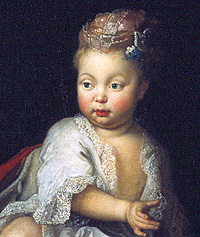
3 July: Princess Friederike Wilhelmine Sophie von Preußen is born in Berlin.
Her father is Friedrich Wilhelm (1713-1740, King of Prussia, the "Soldier King"), her mother Sophie Dorothea, daughter of Elector Georg von Hannover (1714-1727 King George of England).
1711
10 May: Birth of Friedrich, the future Margrave of Bayreuth and husband of Wilhelmine
1712
21 January: Birth of Crown Prince Friedrich (1740-1786 King of Prussia, "Frederick the Great"); he was Wilhelmine's favourite brother.
1731
3 June: Wilhelmine becomes engaged to the future margrave, Friedrich von Bayreuth.
20 November: Wedding in Berlin
1732
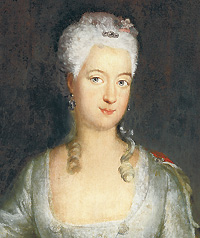
22 January: Arrival of the newly wedded couple Wilhelmine and Friedrich in Bayreuth
30 August: Birth of their daughter Elisabeth Friederike Sophie (1732-1780; the couple's only child)
1735
7 May: After the death of his father Georg Friedrich Karl, Friedrich becomes Margrave of Bayreuth (1735-1763).
3 July: Wilhelmine's husband presents her with the Hermitage on her birthday, and she immediately starts to redesign it.
1736
Rebuilding of the Hermitage Old Palace commences.
1737/38
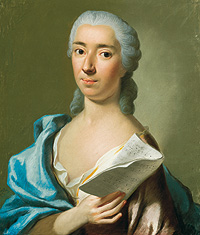
In 1737 the first Italian musicians come to Bayreuth. In the same year Wilhelmine takes over as director of the court opera.
At the margravine's instigation, a "whole caravan" of Italian stage artists arrives in Bayreuth in 1738, including the composer Paganelli and the singer Giacomo Zaghini.
1740
10 May: Premiere of the opera "Argenore" composed by Wilhelmine for the margrave's birthday
1743
Wilhelmine commissions her court architect Joseph Saint-Pierre to build an open-air theatre in the form of a ruin in the Hermitage Court Garden.
In the Redoutenhaus (next to the future Margravial Opera House), Wilhelmine and Voltaire appear on the stage together ("Bajazet" by Racine).
1744

29 August: The theatre of the Hermitage, an imitation ruin, is used for a performance for the first time on the occasion of the marriage of Wilhelmine's sister Luise Ulrike.
From 1744 to 1747 Wilhelmine writes her memoirs.
1745
Work begins on the Margravial Opera Hause; architects: Joseph St. Pierre (exterior) and Giuseppe Galli Bibiena together with his son Carlo (interior).
Sanspareil, the first Chinese "Rock Garden" on the continent, is laid out under the direction of Wilhelmine; it includes a number of interesting architectural features.
1748
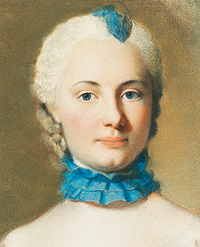
27 September: Inauguration of the Opera House on the occasion of the wedding of Princess Elisabeth Friederike Sophie von Bayreuth and Duke Carl II Eugen von Württemberg
1749
The distinctive features of the Hermitage, the Orangery and the Temple of the Sun, are built to Wilhelmine's specifications.
1750
The Margravial Opera House is completed.
1750-52
The groups of statues in the Hermitage Court Garden are erected.
1751
The Chinese Mirror Cabinet at Hermitage Old Palace is furnished.
1753
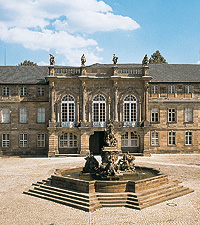
26 January: Fire in the Old Palace of Bayreuth
The New Palace is begun in the same year, incorporating existing buildings; the north wing is designed by Wilhelmine herself.
Conclusion of the work on Hermitage New Palace
1754
First performance of the Festa teatrale "l'Huomo", based on Wilhelmine's French opera poem "l'Homme".
1754-55
Trip to France and Italy
The first plans are drawn up for the Court Garden of the New Palace.
1756
Foundation of an Academy of Arts and Sciences in Bayreuth
1757
Galleries are added to the ground floor and upper floor of the New Palace.
1758
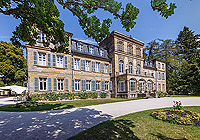
Fantaisie Palace in Donndorf near Bayreuth, the future residence of Wilhelmine's daughter Elisabeth Friederike Sophie, is begun.
14 October: Margravine Wilhelmine von Bayreuth dies. From this point on there are no more performances in the opera house.
1759
Margrave Friedrich marries again: his second wife is Princess Sophie Caroline von Braunschweig-Wolfenbüttel, a niece of Wilhelmine's.
The Italian Palace south of the New Palace is built as a residence for Sophie Caroline.
1763
26 February: Margrave Friedrich von Bayreuth dies without a male heir. This is the end of the extravagant court life in Bayreuth. Friedrich Christian, an uncle of the margrave, becomes the next ruler.
1769
20 January: Margrave Friedrich Christian dies without a male heir. In accordance with a contract regulating succession dating from 1752, Bayreuth falls to Ansbach. Margrave Alexander is now ruler of both margraviates.
1791
2 December: Margrave Alexander signs an abdication document in favour of Prussia.
1792
Prussia takes over the Ansbach-Bayreuth territories.
1806
In the course of the War of the Fourth Coalition, Ansbach-Bayreuth is occupied by French troops. Napoleon keeps Bayreuth for himself, placing it under French military jurisdiction.
1810
Bayreuth is ceded to Bavaria for a payment of 15 million francs.

Recommendation in the social media
Facebook Twitter Google Plus